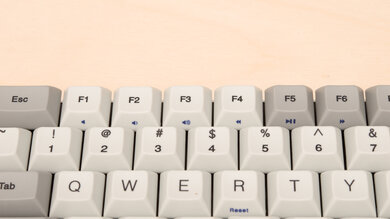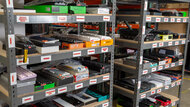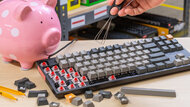The Vortex Race 3 is a solid overall mechanical keyboard. It's one of the better-built keyboards we've reviewed so far, and it's offered in a wide variety of Cherry MX switches, so you'll be sure to find one that suits your needs. The keys have a linear level design and feel very nice to type on. The typing experience is light with the Brown switches, but the ergonomics of the board aren't the best. It only features one incline setting that can be set by screwing in additional feet. It also has a non-typical layout with a TKL 75% design. It's about the size of most 60% or 65% keyboard but features a few more keys like a TKL keyboard. This enthusiast keyboard also comes with colored keycaps for a more unique style.
Our Verdict
The Vortex Race 3 is good for gaming. Its keys are quick to actuate, and it feels very responsive. It's also one of the better-built keyboards we've seen so far, so it should last you a while. However, this version lacks backlighting, although there's one with RGB lighting.
-
Amazing metal build quality.
-
Excellent typing quality.
-
Low latency.
-
Macro-programmable keys.
-
No dedicated software with interface.
-
No backlighting.
The Vortex Race 3 is a wired-only keyboard that isn't designed to work with mobile smart devices.
The Vortex Race 3 is a good keyboard for the office. The model we tested has Cherry MX Brown switches, which offer an excellent typing quality with great tactile feedback. It's also quiet enough to use in an open-office environment, but going with clicky switches might not be. On the upside, it's a very well-built keyboard that should last you for years, and it's also fully compatible with Windows, macOS, and Linux, which makes it very versatile.
-
Amazing metal build quality.
-
Excellent typing quality.
-
Fully compatible with Windows and macOS.
-
No dedicated software with interface.
The Vortex Race 3 is a decent keyboard for programmers. It has an excellent typing quality and is available with many different Cherry MX switches, so you should find one that suits your needs. However, it doesn't have the best ergonomics, although the keycaps have a linear level design which is quite comfortable to type on. Programmers should also appreciate the ability to program every key and to create three additional layers.
-
Amazing metal build quality.
-
Excellent typing quality.
-
Macro-programmable keys.
-
No dedicated software with interface.
-
No backlighting.
-
Wired-only.
The Vortex Race 3 is bad for use with a home theater PC. It's a wired-only keyboard with no trackpad, so you need to run a cable from the couch to the computer and a separate mouse for navigation. Although our unit doesn't have backlighting, you can get one that does.
-
Amazing metal build quality.
-
Excellent typing quality.
-
No dedicated software with interface.
-
No backlighting.
-
No trackpad.
-
Wired-only.
- 7.6 Gaming
- 4.4 Mobile/Tablet
- 7.9 Office
- 7.2 Programming
- 3.5 Entertainment / HTPC
Changelog
- Updated Feb 04, 2021: Converted to Test Bench 1.0.
- Updated Mar 06, 2020: Review published.
- Updated Mar 03, 2020: Early access published.
- Updated Feb 27, 2020: The product has arrived in our lab, and our testers will start evaluating it soon.
- Updated Feb 11, 2020: We've purchased the product and are waiting for it to arrive in our lab.
Check Price
Differences Between Sizes And Variants
The Vortex Race 3 is available in a lot of different switches. Most of our review should still be valid for all of them, but the overall typing experience should change drastically depending on which switches you go for. You can choose between Cherry MX Brown (which we tested), Red, Blue, Black, Silent Red, Silver Speed, and Clear. There's also a variant of this keyboard that has RGB backlighting. This variant is available with Silent Black switches rather than Clear switches.
Compared To Other Keyboards
The Vortex Race 3 is a mechanical keyboard that stands out for its unique design. It's categorized as a TKL 75% layout, which is about as small and compact as a 60% or 65%, but has a few more keys, similar to a TKL layout. It's available in many different switches, which is great. It's also one of the boards with the best build quality we've tested thanks to its full metal frame. For more options, check out our recommendations for the best keyboards, the best mechanical keyboards, and the best keyboards for writers.
The Redragon K552 KUMARA RGB and the Vortex Race 3 are both TenKeyLess mechanical keyboards with significant differences. The Redragon has clicky Outemu Blue switches and full RGB backlighting, which the variant of the Vortex we tested lacks, although there's a variant with RGB lighting available. The Vortex has a non-typical TKL layout that's similar to the size of a 60% keyboard but with several more keys. It also has significantly lower latency, more solid-feeling build quality, and better typing quality. Our version has Cherry MX Brown switches, but it’s also available with a range of other Cherry MX switches, including Red, Blue, Black, Silent Red, Silver Speed, and Clear, as well as Silent Black, specifically available for the RGB variant.
The Das Keyboard X50Q is a slightly better keyboard for professionals than the Vortex Race 3. Its full-size design gives you access to more keys but does take a bit more space on your desk, especially if you use the included wrist rest. On the other hand, the Vortex is better-built thanks to a metal frame, but it doesn't have any backlighting like the Das, although an RGB variant exists. The X50Q also gives you access to 'applets' to show you desired information, which the Vortex can't do.
The Ducky One 2 Mini V1 is better than the Vortex Race 3, although mainly because it has backlighting, which the Vortex lacks. The Vortex has better build quality, and it's better for gaming because it has lower latency. Also, even though both of our units are fitted with Cherry MX Brown switches, the Vortex's are lighter and easier to actuate. The Ducky provides a better typing experience. That said, both keyboards are available in a wide variety of switches, so the typing experience depends on which ones you get.
The Obinslab Anne Pro 2 and the Vortex Race 3 are quite different. The Vortex is a wired-only 75% keyboard, while the Obinslab is a compact 60% and can be used wired or wirelessly. The Obinslab's wireless connectivity makes it more versatile because it can be used with more types of devices. Also, it has a multi-pairing feature that lets you pair up to four devices simultaneously. The Obinslab is much better for gaming due to its lower latency and software support. Our Vortex unit doesn't have backlighting, but you can a variant that does. Both keyboards provide an excellent typing experience and are available in various switch options.
The Vortex Race 3 is much better than the IBM Model M. It has a better build quality, each key is macro programmable, and you can save up to four layers of customization directly to the keyboard's on-board memory. However, the Model M offers a better typing experience and it's more comfortable to type on.
The Ducky MIYA Pro and the Vortex Race 3 are both wired mechanical keyboards that are available in various switch options. Even though the Ducky is a compact 65%, it's still wider than the TKL 75% Vortex, which offers more keys. The Vortex has lower latency, making it a better choice for gaming. Our unit doesn't have backlighting, although there's a variant that does. The Ducky has software for customization, which the Vortex lacks, but it's hard to use.
The Keychron K4 and the Vortex Race 3 are very different keyboards. The Vortex is a wired-only keyboard and can only be used with desktop operating systems, while the Keychron is a wireless Bluetooth keyboard and has a multi-device pairing feature. Both keyboards can be configured with your preferred type of mechanical switches, and neither of them has software support for customization. However, all keys on the Vortex are macro-programmable using a macro recording sequence on the keyboard. Our Vortex unit doesn't have backlighting, but you can get a variant that does. If you plan on using it for gaming, the Vortex has lower latency.
The Vortex Race 3 and the Keychron K2 (Version 2) are both 75% keyboards with a similar layout, but the Vortex is wired-only while the Keychron is wireless with Bluetooth connectivity. The Keychron is more versatile because you can use it with mobile devices and pair it to multiple devices at once. If you're planning on using it for gaming, though, the Vortex is better because it has lower latency and macro-programmable keys. Also, it has onboard memory to save custom profiles. Both keyboards are available in various switch options, and the Vortex has a variant with backlighting.
The Vortex Race 3 and the Drop CTRL are similar TenKeyLess keyboards, but the Vortex is a slightly smaller (75%) size, while the Drop is an (80%) keyboard. We tested both keyboards with Cherry MX Brown switches, but both are available in a range of different switch types. The Vortex also has an additional incline setting and lower latency. On the other hand, the Drop is hot-swappable and has full RGB backlighting with individually-lit keys, while the Vortex lacks backlighting. Both keyboards lack customization software, but you can program macros directly on the Vortex itself, and for the Drop, you can set macros via the QMK firmware tool on Drop's website.
Test Results
The Vortex Race 3 is a very compact keyboard. Although it's described as a TKL 75%, its dimensions are closer to a compact design like the Ducky One 2 Mini V1 or the Obinslab Anne Pro 2.
The Vortex Race 3's build quality is excellent. The frame is entirely made out of metal. It feels solid and doesn't flex at all. It features Dye Sub PBT keycaps that feel durable, and the keys themselves are very stable, although the spacebar has a small amount of rattle. The incline feet are screwed in and feel sturdy, but the rubber pads feel a bit cheaper and might peel off over time.
The ergonomics are mediocre. This board has a straight design and usually lays flat. However, it comes with a set of feet, which will give you a small incline. They need to be screwed in, though, so it's not as easy to set or take off as typical folding keyboard feet. Some people might need a wrist rest, but unfortunately, it doesn't come with one.
The Vortex Race 3 doesn't have backlighting, although there's a variant that supports full RGB lighting.
The included micro-USB cable is detachable, which is nice. The cable has white markings and gives off cheap overall vibes, but on the upside, it's very easy to replace if you want to modify the style of your keyboard.
The Vortex Race 3 is wired-only and can't be used wirelessly.
Every feature available on this keyboard is accessible through the board itself. All media keys are hotkeys on the F keys, and you can program macros on all keys as well. The macro recording sequence might be a bit tricky at first, but it works well. You can create three additional layers, and each has a different LED light color, which is situated under the spacebar. You can also activate Game Mode to prevent your Windows key from minimizing your game by pressing Fn+End.
The Cherry MX Brown used on this board might feel a bit less tactile than others. Its tactile bump isn't as pronounced as other keyboards we've reviewed like the Ducky One 2 Mini V1. Also, while our unit features Cherry MX Brown switches, this board is also available in a wider variety including Blue, Red, Black, Clear, Silver Speed, and Silent Red. Different switches will result in different keystrokes and typing experience. If you're interested in a TenKeyLess keyboard that's hot-swappable and allows you to change switch types without soldering, check out the Keychron C1.
The typing quality provided by the Vortex Race 3 is excellent. It's very natural to type on once you get used to the linear profile of the keycaps. They also feel very nice, and the tactile feedback is good. All keys are stable, including the spacebar. Overall, typing on this keyboard feels great, and you shouldn't feel fatigue after a while.
Typing noise on this keyboard isn't too loud and should be suitable for an open-office environment.
The Vortex Race 3 has great latency. It isn't as good as keyboards that are designed specifically for gaming, like the Razer Huntsman Mini, but it's good enough for most gamers.
Although this keyboard doesn't have downloadable software with an interface, you can still customize some things directly on the board itself. All four layers can be saved directly on the board, so your macros will stay if you use the keyboard with another computer.
This keyboard has great compatibility. All keys work on Windows, macOS, and Linux, making it quite versatile. However, since it can't be used wirelessly, it won't be the best option for mobile smart devices.
Comments
Vortex Race 3: Main Discussion
Let us know why you want us to review the product here, or encourage others to vote for this product.





























